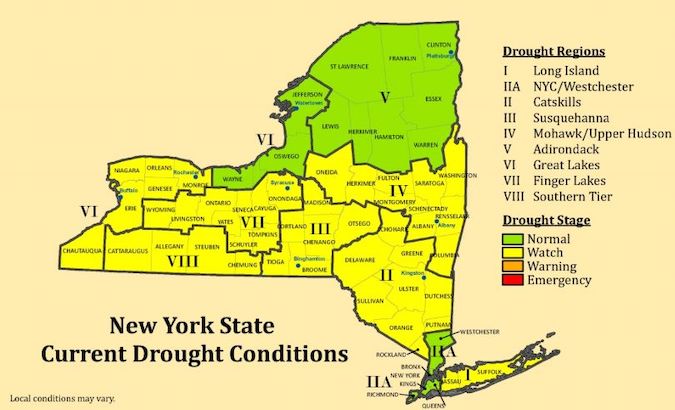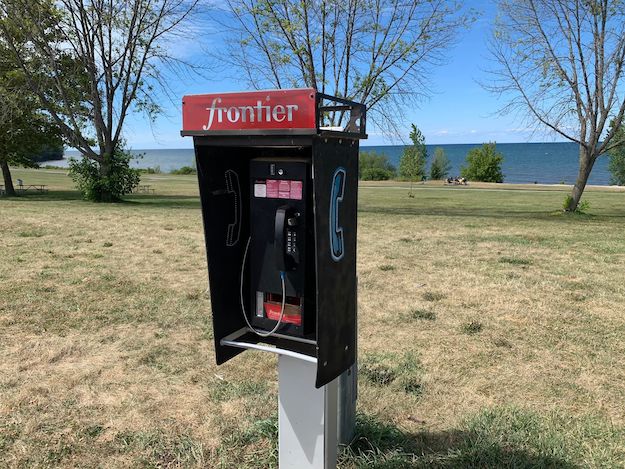Orleans, GLOW region continue to be in drought watch
State expands counties in watch, the first of 4 levels of drought advisory

MAP from NYS Department of Environmental Conservation: Many counties and regions of New York State are in a drought watch, the first level of a drought advisory. With a drought watch there are no statewide mandatory water use restrictions in place, but residents are strongly encouraged to voluntarily conserve water. Local public water suppliers may require conservation measures, depending upon local needs and conditions.
Press Release, Gov. Kathy Hochul’s Office
Governor Kathy Hochul today directed the New York State Department of Environmental Conservation to issue an updated drought watch after consulting with the State Drought Management Task Force and federal partner agencies.
The watch now includes most New York counties except those located in the Adirondack, Eastern Great Lakes, and New York Metropolitan regions. New York State is encouraging residents in affected counties, particularly those dependent on private groundwater wells, to conserve water whenever possible during the coming weeks.
“While recent rains have helped, severe dry conditions continue to persist across the state,” Governor Hochul said. “New Yorkers should take steps to conserve water whenever possible in the areas now under a designated drought watch. Simple steps to reduce water consumption will be crucial to our efforts to help prevent any increased drought levels.”
Orleans County and the GLOW region are among the areas are a drought watch. A watch is the first of four levels of State drought advisories, which are watch, warning, emergency, and disaster. No mandatory restrictions are in place under a state drought watch.
“This year’s below normal precipitation and above-normal temperatures continue to combine to exacerbate low stream flows, reduced groundwater levels, and ongoing wildfire risk,” said Department of Environmental Conservation Commissioner Basil Seggos. “The DEC will continue to monitor water levels and the environmental impacts of the dry conditions and encourage residents throughout the state to monitor usage and avoid wasting water.”

Photo by Tom Rivers: A rare sighting of a pay phone at Hamlin Beach State Park on Sunday shows grass showing the effects of too little rain this summer.
An increasing number of water supply challenges are being reported due to dry conditions. Below-normal precipitation during the last three months, low stream flows and low groundwater levels prompt the need for the expansion of the watch status to ensure adequate public water supplies. Local public water suppliers are urged to assess the current situation, promote voluntary conservation, and take appropriate actions to manage risk.
DEC and U.S. Geological Survey are partners in evaluating hydrologic conditions across New York State. In addition, DEC supports efforts by local governments and stakeholders to undertake water conservation measures based on specific local circumstances.
Observed precipitation has been less than normal with shortfalls of two to six inches common over the last 90 days. The dry weather began in the spring and is beginning to significantly affect other metrics. Stream flows and groundwater levels are well below normal throughout much of the affected regions. Groundwater levels have been declining over the past few months and they are not expected to improve in the immediate future due to the existing precipitation deficit.
The National Weather Service outlook for the remainder of the summer predicts above-normal temperatures and below-normal precipitation. By voluntarily reducing water usage, and being extra careful with fire and outdoor flames, New Yorkers can help conserve our natural resources during these dry days of summer.
To protect water resources, homeowners are encouraged to voluntarily reduce outdoor water use and follow these tips:
- Water lawns only when necessary, choose watering methods that avoid waste, and water in the early morning to reduce evaporation and maximize soil hydration;
- Reuse water collected in rain barrels, dehumidifiers, or air conditioners to water plants;
- Raise lawn mower cutting heights. Longer grass is healthier with stronger roots and needs less water;
- Use a broom, not a hose, to clean driveways and sidewalks; and
- Fix leaking pipes, hoses, and faucets.







































































